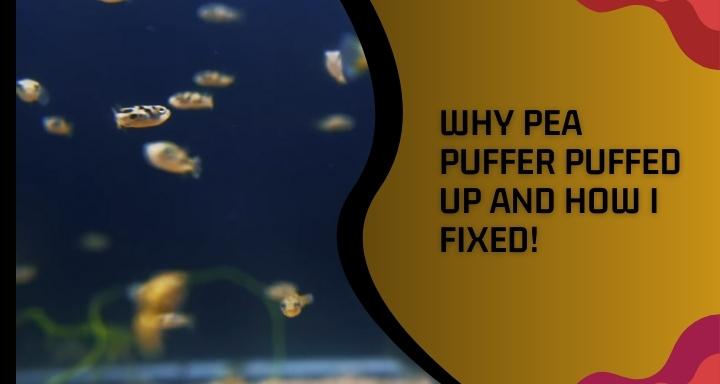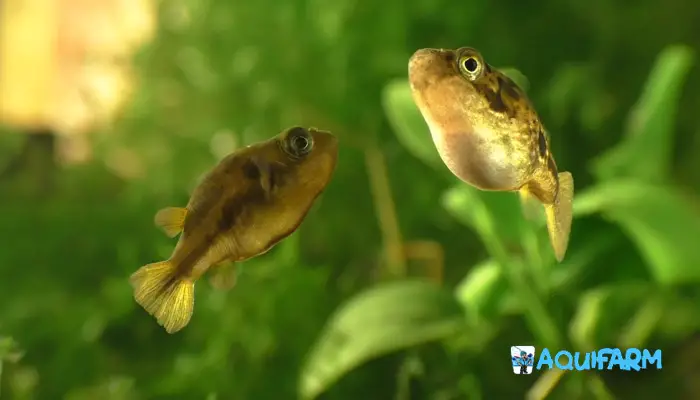
Pea puffer fish (also known as dwarf puffer) is famous in aquariums for its small size and bright color. However, one issue that beginners often need clarification on is the pea puffer being puffed up. This is basically a defense mechanism of the puffer fish. Still, several other reasons can cause your puffer fish to puff up, such as perceived threat, illness or injury, and breeding behavior.
But there is nothing to despair about. In this article, I will discuss in detail all the reasons for the Pea Puffer Puffed Up and tell you how to fix it. So without delay let’s get started.
3 Reasons For Pea Puffer Puffed Up and Treatment
1. Perceived Threat
If you shift your pea puffer fish to a new tank or put new fish in the same tank, the puffer fish may become stressed and puff up. I once put a pair of goldfish in the tank of my puffer fish. Soon after my pair of puffer fish puffed up and tried to scare away the goldfish.
Pay close attention to whether your fish have this problem right after changing the water in your aquarium! Sometimes puffer fish are puffed up due to poor water quality. If the water does not have enough oxygen or the water acidity is too high, your fish will not have their natural environment. Unable to adjust, they get scared and puffed up.
And whenever your puffer fish gets scared, it inflates itself by letting water or air into its belly. This causes the fish to bloat quickly. Pufferfish do this primarily to appear larger and more intimidating to potential enemies.
How To Fix
If your puffer fish is puffed up from fear or stress, the first thing you need to do is find out what is causing the fish to be afraid or stressed. I can say from my experience that puffer fish basically do not like the presence of other fish in their tank. So, avoid putting other fish in the puffer fish tank. But if your fish behaves normally with other fish then you can keep it.
The second thing you need to do is use clean water in the tank. Pea puffer fish prefer fresh water. Also, you should make sure that the water temperature never exceeds 85°F. Water temperatures of 70°-80°F are ideal for puffer fish. The pH of the water should be 7-8 and the hardness should be 6-12 dGH. No toxic material should be added to the water.
Regular cleaning of your puffer fish tank is a must. In this case, you can use a good filtration system. Which will automatically keep your tank water clean and quality. When changing the water, the new water should be reserved for at least 24 hours and the composition should be the same as the old water.
In this case, I would advise you to do 20-30% water changes per week rather than changing the whole water at once.
2. Illness or Injury

Illness or injury is one of the causes of pea puffer fish puffing up. Pufferfish with swim bladder disease puff up frequently. The swim bladder is an internal organ in puffer fish that helps the fish control their buoyancy in the water.
When this organ in your fish is damaged or diseased, it can cause a variety of problems for the fish, including difficulty swimming, floating on the surface, or sinking to the bottom.
If your pea puffer fish swims upside down with frequent puff-ups, floats on top or bottom of the tank, can’t swim or balance, and slows down eating, your fish is definitely suffering from swim bladder disease.
How To Fix
After identifying the diseased fish, it is necessary to know what causes the fish to be affected by that disease. Treatment will be much easier for you if you catch the underlying cause early on. Factors such as bacterial or parasitic infections, bad water, overfeeding, and physical trauma are responsible for swim bladder disease in puffer fish.
You must follow chemical treatment for bacterial or parasitic infections. In this case, the affected fish should be transferred to a separate container and the medicine should be applied. Any good quality anti-bacterial suitable for puffer fish is effective for these diseases. However, the manufacturer’s instructions must be followed.
Pea puffers are known as peaky eaters, so you can feed them live or frozen food such as bloodworms, brine shrimp, daphnia, and small crustaceans like shrimp or krill.
Although they are frequent feeders, excess food should not be given to the tank. I would suggest you give a maximum of two to three meals a day. You should only feed them as much as they can consume in a few minutes.
3. Breeding Behavior

A common cause of pea puffer fish puff-up is reproduction. If you have several pairs of puffers in your puffer tank, watch during the breeding season to see the male puffers puffing up their bodies as much as possible to make them look bigger and more intimidating to other males.
When a male puffer is ready to breed, he becomes more aggressive towards other males in the tank and chases them away from potential mates. As part of this behavior, he inflates his body and can make his fins appear larger and more dominant.
How To Fix
As Pea Puffer’s breeding behavior is a natural issue, no precautions are needed in this regard. However, provision should be made to provide puffers with plenty of hiding places and plant cover during breeding behavior to reduce fish stress and aggression.
You can add live plants like Java moss, Anubias, and Java ferns to the tank, as well as artificial decorations like caves, rocks, and driftwood.
At Least a 10-20 gallon tank should provide your puffer fish during breeding seasons. Water quality should be maintained very strictly. If you notice excessive aggression or aggression towards other fish in the tank, move the fish to a separate tank and provide more hiding places to create a peaceful environment.
How Fresh Water Pea Puffer Puffed Up
A puffer fish has an elastic lining covering a large area near its belly; which allows it to expand to several times its normal size when needed. Whenever the pea puffer fish is threatened or frightened, the fish quickly absorbs large amounts of water or air, inflates its belly, and tries to stretch the skin.
Some species of puffer fish, in addition to inflating the skin of the abdomen, also erect the spines. Which gives them a more menacing look.
Pea Pufferfish puff up as a defensive mechanism to increase their size to prevent potential enemies from swallowing them. And can scare the enemy and run away. But while puffing is an effective defense mechanism, it requires a lot of energy from your fish.
As a result, the fish gets tired and weak very quickly. In some cases, puffing can increase the size of the fish and trap the fish in a small area, giving a potential enemy an advantage.
Frequently Asked Questions (FAQs)
Will pea puffers stop eating when full?
Pia puffer fish use a lot of energy when puffed up or bloated. So not eating puffed up puffer fish could be a sign of another problem. In this case, the puffer fish should be observed very well and the root cause should be tried to be found.
How do I know if my pea puffer is happy?
One of the characteristics of the Happy Pia Puffer fish is a pure white belly. Also, the happy fish will move around the tank very naturally, eat properly, and not be puffed up.
Are pea puffers sensitive to light?
Yes, they like less light. Puffer fish often behave aggressively in direct light. For this, their tank should be provided with adequate hiding space.
Final Words
Pea puffer fish can be puffed up sometimes due to natural causes and sometimes as symptoms of a dangerous issue. So first you need to know the underlying cause. If this is due to natural causes then the fish should be provided with its desired environment. Adequate care should be taken.
There is nothing to worry about if the problem is due to some other issue as well. Taking timely action and following my suggestions in this article can easily fix this problem in your fish.
- Top 15 Freshwater Aquarium Plant Ideas for a Lush, Green Tank - November 9, 2024
- Top 13 Freshwater Aquarium Layout Ideas for a Beautifully Organized Tank - November 9, 2024
- 14 Stunning Rustic Freshwater Aquarium Ideas for a Tranquil Environment - November 9, 2024
